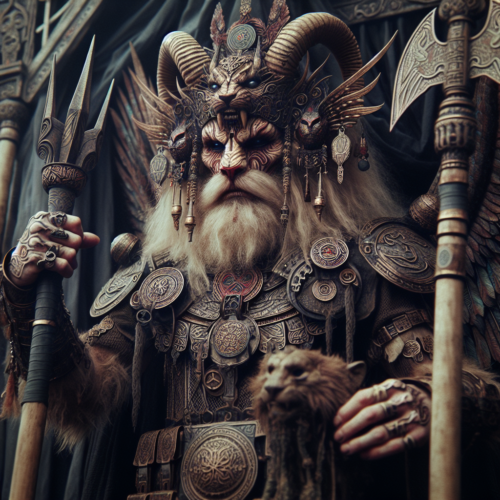Nergal is the Mesopotamian god that embodies war, pestilence, and death. His parents are Enlil and Ninlil, both chief deities in the Mesopotamian pantheon.
This ancient deity, whose worship spanned from the Early Dynastic to the Neo-Babylonian times, was a personification of the inexorable forces of war, disease, and mortality. Nergal’s dominion was the shadowy realm of Kur, the underworld of Mesopotamian belief, where he reigned with a fearsome mace in hand, often depicted with the head of a lion—a symbol of his might and dread power.
Nergal’s origins are rooted in the scorching heat of summer that withers crops and brings hardship, reflecting his initial role as an agricultural god. However, as the centuries passed, his persona deepened and darkened, transforming into the overlord of the netherworld and a harbinger of plague and conflict. His marriage to Ereshkigal, the sovereign of the dead, further cemented his status as a king of the afterlife, a narrative detailed in the myth “Nergal and Ereshkigal”. This demonstrated his power, as he basically conquered the underworld, a feat that even Inanna herself could not accomplish.

The worship of Nergal
Throughout Mesopotamia, from Nineveh to Uruk and Babylon, shrines rose in his name, and his followers performed rituals to appease his destructive nature and seek his protection. The recitation of the “Epic of Erra,” which recounts Nergal’s wrathful escapades, was a central part of these ceremonies, believed to repel malevolence and align with the god’s dual role as both a source and a shield against devastation.
Nergal’s reach extended into the practice of divination, where omens of war and demise were interpreted under his watchful gaze. His association with calamitous events underscored his sovereignty over the darker aspects of existence. Even beyond the Sumerian and Babylonian cities, Nergal’s veneration was evident, as he was recognized in the Hebrew Bible as the deity of Cuth.
Nergal has a paradoxical nature. He was both feared for his capacity to unleash destruction and sought after for his protective embrace. His narrative and worship provide a window into the ancient Mesopotamian psyche, grappling with the chaos of war and the enigma of death. Through the myths and rituals that surrounded him, Nergal was a figure that embodied the trepidation and aspirations of the people of that era, a deity who commanded both awe and reverence in the face of life’s most formidable challenges.
Appearances in modern culture
Books
- City of the plague god (2022) – Rick Riordan
- The Hand of Nergal (1930) – Robert E. Howard
- The Sandman series (2018-2020) – Neil Gaman
TV series
- “The Grim Adventures of Billy & Mandy“ – Nergal is a recurring character in this animated series, where he is depicted as a demonic being causing trouble and mischief for the main characters, Billy and Mandy.
- “Grim & Evil” – Nergal appeared in “Grim & Evil,” which is the original series from which “The Grim Adventures of Billy & Mandy” was spun off.
